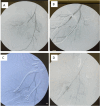User experience and hemostatic efficacy: Comparative analysis of commercial agents in junctional and hepatic hemorrhage models
- PMID: 40880351
- PMCID: PMC12396726
- DOI: 10.1371/journal.pone.0330696
User experience and hemostatic efficacy: Comparative analysis of commercial agents in junctional and hepatic hemorrhage models
Abstract
Background/objectives: Hemorrhage is associated with most preventable combat-related deaths. Management of non-compressible truncal and junctional hemorrhage remains challenging, especially with prolonged evacuations. This study evaluated the efficacy of commercial topical hemostatic agents in uncontrolled hemorrhage models under coagulopathic conditions, examining differences based on applicator experience.
Methods: Sixty Yorkshire swine were randomized to 5 groups: Combat Gauze (CG), Celox Rapid (CR), ChitoSAM 100 (CS), EVARREST® Fibrin Sealant Patch (EP), and X-Stat 30 (XS). After 50% hemodilution, a 5 mm femoral arteriotomy or 6 cm liver laceration was created, and the agents were applied as per device instructions. Hemostatic agents were placed by experienced (≥5 previous applications) or non-experienced (<5 previous applications) users. Animals were then monitored for rebleeding for 60 minutes.
Results: In the junctional hemorrhage model, only ChitoSAM required more applications by novice applicators (2.3 vs. 1, p = 0.0104). No significant differences in rebleed rates among devices (CG 0%, CS 33%, CR 17%, EP 17%, XS 33%, p = 0.73) or by user experience were observed. No differences in perfusion were noted on angiography. In the hepatic laceration model, no significant differences in applications or rebleed rates for any agent (CG 0%, CS 50%, CR 17%, EP 17%, XS 0%, p = 0.21) or by user experience were found. Overall survival did not significantly vary by device.
Conclusion: All 5 hemostatic agents showed similar efficacy in controlling junctional and intra-abdominal hemorrhage, with no significant differences in hemostasis, rebleed rate, or survival by experience level. However, more ChitoSAM applications were needed for junctional hemorrhage control in the absence of experience. All tested dressings show promise for rapid hemorrhage control.
Copyright: This is an open access article, free of all copyright, and may be freely reproduced, distributed, transmitted, modified, built upon, or otherwise used by anyone for any lawful purpose. The work is made available under the Creative Commons CC0 public domain dedication.
Conflict of interest statement
The authors have declared that no competing interests exist.
Figures






References
-
- Glaser JJ, Fisher AD, Shackelford SA, Butler F, Rasmussen TE. A contemporary report on US military guidelines for the use of whole blood and resuscitative endovascular balloon occlusion of the aorta. J Trauma Acute Care Surg. 2019;87(1S Suppl 1):S22–7. doi: 10.1097/TA.0000000000002301 - DOI - PubMed
-
- Kelly JF, Ritenour AE, McLaughlin DF, Bagg KA, Apodaca AN, Mallak CT, et al. Injury severity and causes of death from Operation Iraqi Freedom and Operation Enduring Freedom: 2003–2004 versus 2006. J Trauma. 2008;64(2 Suppl):S21–S27. - PubMed
Publication types
MeSH terms
Substances
LinkOut - more resources
Full Text Sources
Medical

